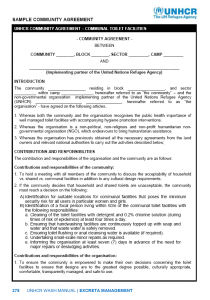 |
F801/2015a – Toilet Block Management Sample Community Agreement (UNHCR, 2015)This toilet block management sample community agreement can help define the responsibilities of the different stakeholders in operation and maintenance of WASH facilities from filling up the hand-washing water containers, and keeping the surroundings clean, to providing maintenance.
|
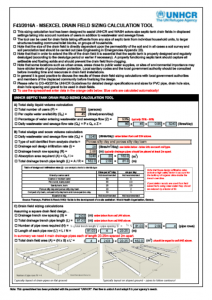 |
F-402/2016a Drain Field Sizing Spreadsheet (UNHCR, 2016)This sizing calculation tool has been designed to assist UNHCR and WASH actors correctly size drain fields for septic tanks in displaced settings taking into account numbers of users, soil type, and wastewater and sewage flows.
|
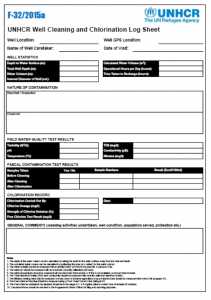 |
F-302/2015a Well Cleaning and Chlorination Log Sheet (UNHCR, 2015)This is the standard UNHCR well cleaning and chlorination template for refugee settings available in PDF and MSExcel formats. The form should be completed each time a hand dug well is cleaned, chlorinated and tested for faecal coliforms. The form is available in MSExcel format so WASH actors can adapt the content to the context.
|
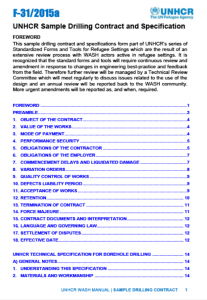 |
F-301/2015a Sample Drilling Contract and Specifications for Refugee Settings (UNHCR, 2015)This is the standard UNHCR borehole drilling contract template for refugee settings available in PDF and MSWord formats. The contract also includes a technical specification for drilling which defines the following borehole construction requirements: drillpipe diameters; casings and screens; hydrogeological survey; identification of drilling sites; abandoned boreholes; drilling equipment and depths; plumbness and alignment; temporary lid; artificial and natural gravel pack; well development; sanitary seal; pumping tests; borehole yields; borehole pollution; borehole disinfection; and water samples.
|
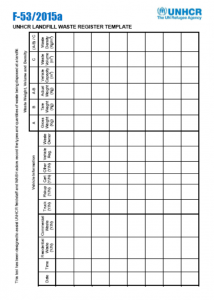 |
F-503/2015a UNHCR Landfill Waste Register (UNHCR, 2015)UNHCR field staff and their partners should use this waste register form to keep a record of the types and quantities of waste being disposed at each landfill facility. Ideally waste management short, medium and long term strategies for different waste streams should be re-evaluated and re-organised based on the data collected from this tool.
|
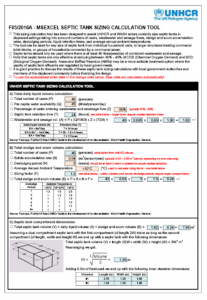 |
F-401/2016a Septic Tank Sizing Spreadsheet (UNHCR, 2016)This sizing calculation tool has been designed to assist UNHCR and WASH actors correctly size septic tanks in displaced settings taking into account numbers of users, wastewater and sewage flows, sludge and scum accumulation rates, desludging periods, liquid retention times, and average annual ambient temperatures.
|
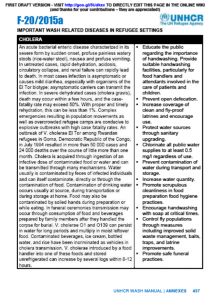 |
F-200/2015a Summary of Important WASH Diseases in Refugee Settings (UNHCR, 2015)This document provides a quick summary of the most important WASH related diseases for refugee settings and includes a list of recommended control strategies.
|
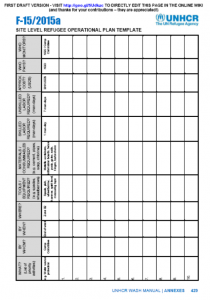 |
F-105/2015a Site Level Refugee WASH Operational Plan Template (UNHCR, 2015)This template can be used to help UNHCR and WASH actors establish a simple WASH operational plan (WHO will do WHAT, WHERE, WHEN, and HOW and WHO will PAY and WHO will MONITOR). This template can be used in addition to the site level WASH Strategy Template.
|
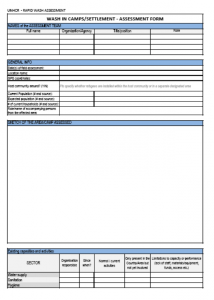 |
UNHCR WASH Rapid Assessment Forms (UNHCR, 2015)These rapid (emergency) assessment tools can be used to help assess water supply, excreta management, solid waste management, hygiene and disease vector control conditions in the following refugee settings: These rapid (emergency) assessment tools can be used to help assess water supply, excreta management, solid waste management, hygiene and disease vector control conditions in the following refugee settings: Camps; Settlements; Transit Centres; Schools; Health Centres and Urban Settlements. It also contains references to UNHCR’s WASH indicators and recommendations for data collection.
|
 English
English
